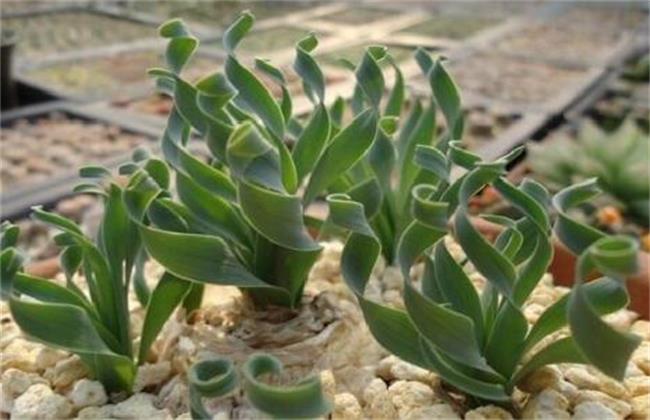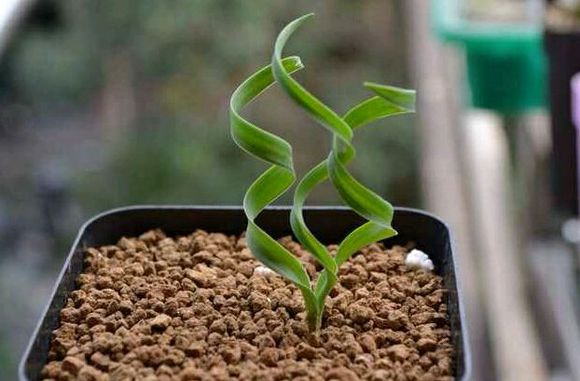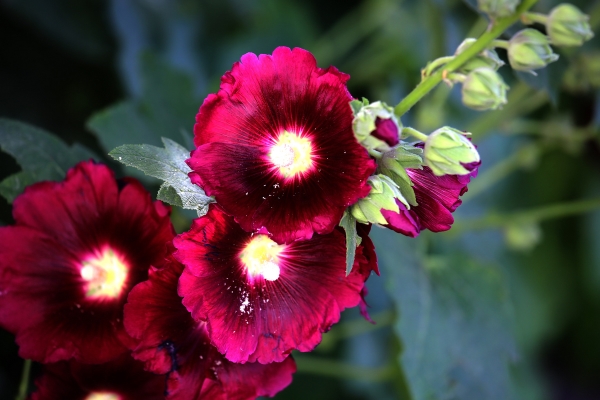Culture methods of Spring Grass
Light
Spring grass likes to grow in places with light, sufficient light can meet the growth needs of spring grass, make it circle and twist, and has high ornamental value. If the light is not enough, the leaves will be thin, curly and unornamental. But in the hot summer, it is necessary to put up a sunshade net to shade, so as not to scorch the leaf tip.

Temperature
Spring grass prefers a shady environment and is afraid of heat. It can grow normally when the temperature is above 10 ℃ in winter, and it can pass the winter safely when it is not less than 5 ℃. In summer, the plant begins to dormancy, the leaves will dry up, can be placed in a ventilated and dry place to spend the summer, after entering the autumn can grow again, normal management can be.
Soil
Spring grass likes to grow in fertile and loose soil and requires rich humus in the soil. Generally, rotten leaf soil or peat soil can be selected and mixed with knowledge and sand to ensure its good drainage, and some bone powder can be added to the soil as base fertilizer.
Watering
It is necessary to keep the soil moist during the growth of spring grass, but there can be no stagnant water at the bottom, because the stagnant water at the bottom will lead to the rot of spring grass bulbs, but we should also be careful not to lack water, otherwise it will lead to stagnation of spring grass plant growth and yellowing of leaves. We can often spray water like the plants of spring grass to ensure high air humidity and timely drainage in the rainy season.
Have you all learned the above breeding methods? What else do we need to pay attention to when breeding?
Culture methods of Spring Grass
The main results are as follows: 1. Spring grass likes cool and afraid of heat, and its main growth period is from September to April of the following year. It is advisable to maintain a temperature of 10 ℃ to 20 ℃ in winter. In this environment, the plant can continue to grow and carry out normal fertilizer and water management. If watering is controlled to make the plant dormant, no less than 5 ℃ can survive the winter safely. In the middle and last ten days of May, with the increase of temperature, the leaves on the ground gradually withered, the plant went into a dormant state, the dry leaves could be removed, the bulbs were left in the original pot for summer, and the flowerpot should be placed in a dry, ventilated and water-free place until the end of August and the beginning of September. As the weather turns cool, new buds will grow from the bulbs and normal management can be restored.
2. Spring grass likes light, and sufficient light should be given during the growing period. if the light is not enough, it will make the leaves weak and the degree of curl is poor, so it is difficult to highlight the unique charm of spring grass. On the other hand, the leaves of the plants growing in sufficient sunshine are low and stout, twisted and twisted, with high ornamental value, but sunshade nets should still be built after April to avoid hot sun exposure and prevent leaf tips from drying up.
3. Spring grass likes the humid environment, and it is appropriate to keep the soil moist without stagnant water during the growing period. if there is a long-term drought and lack of water, the plant will not die, but the growth will stagnate, the leaves yellowing and even withered, while the long-term stagnant water in the basin soil will cause bulb rot. Water can often be sprayed to the plant to increase air humidity and prevent the top of the leaves from drying up. In summer, in order to avoid flooding in the rainy season, the flowerpot can be placed on the shelf or on a stage with a certain height, and pay attention to control watering to prevent the bulb from rotting due to stagnant water, but the pot soil can not be completely dry to prevent the bulb from drying up.
The peak period of plant growth is from October of each year to April of the following year. Mature thin liquid fertilizer or compound fertilizer is applied once a month to provide sufficient nutrients to make the plant grow vigorously. After the flower is extracted in spring, 0.5% potassium dihydrogen phosphate solution is sprayed 2 to 3 times to promote flowering. After flowering, different plants should be selected for artificial pollination to make the plants bear fruit, and the seeds should be harvested after maturity so as not to scatter them; if there are no seeds left, the remaining pedicels should be cut off in time after flowering so as not to consume too much nutrients.
Spring grass is generally changed once a year at the end of August, the basin soil requires fertile and loose, rich in humus, with good drainage and permeability, can be mixed with 3 portions of saprophytic soil or peat soil, 2 parts of vermiculite or sandy soil, and mixed with a small amount of bone powder. Cut off the rotten root system when changing the basin, plant the bulb out of the soil 1 / 3 or so, pour water after planting and maintain it in a place with sufficient light. After that, pay attention to keep the soil moist, and soon new leaves will grow from the top of the bulb.
How to raise spring grass? Introduction to the maintenance methods of Spring Grass
Spring grass, also known as spiral grass, gets its name because its leaves are twisted and shaped like springs. it is a small potted ornamental plant newly introduced in recent years, with unique shape, simple bulbs, leaves according to different varieties, or like springs, or like kelp floating in the water, or like long curly hair, or like iron products, its lines are smooth and elegant, rich in variety, elegant and fresh in color, suitable for planting in small pots, embellished in windowsills, several cases, etc. Strange and interesting. Many flower friends are not very clear about how to raise spring grass, so let's popularize the growth habits of spring grass first.
I. growth habits
Spring grass likes cool, moist and sunny environment, afraid of hot and humid, resistant to semi-shade, but also resistant to drought, has a certain degree of cold resistance. It has the habit of dormant at high temperature in summer and growing in the cool season from autumn to spring. The main growth period is from September to April of the following year, and the temperature of 5 ℃ to 20 ℃ should be maintained in winter, in which the plant can continue to grow and normal fertilizer and water management can be carried out. If watering is controlled to make the plant dormant, no less than 0 ℃ can safely survive the winter indoors.
II. Maintenance methods
In the middle and last ten days of May, with the increase of temperature, the leaves on the ground gradually withered, the plant went into a dormant state, the dry leaves could be removed, the bulbs were left in the original pot for summer, and the flowerpot should be placed in a dry, ventilated and water-free place until the end of August and the beginning of September. As the weather turns cool, new buds will grow from the bulbs, and normal management can be slowly restored. It is worth reminding that summer dormancy, plants do not have no water throughout the summer, can stay slightly moist, although the leaves have dried up. Underground bulbs will still grow, do not water in the center of dry leaves, over a summer, the bulbs grow a lot bigger. Spring grass likes light, the growing period should be given sufficient light, if the lack of light will make the leaves weak, and the degree of curl is poor, it is difficult to highlight the unique charm of spring grass. On the other hand, the leaves of the plants growing in sufficient sunshine are low and stout, twisted and twisted, with high ornamental value, but sunshade nets should still be built after April to avoid hot sun exposure and prevent leaf tips from drying up.
Spring grass likes the humid environment, it is appropriate to keep the soil moist during the growing period without stagnant water. If long-term drought and lack of water, the plant will not die, but the growth will stagnate, the leaves will yellowing, and even withered; while long-term stagnant water in the basin soil will cause bulb rot. Water can often be sprayed to the plant to increase air humidity and prevent the top of the leaves from drying up.
In summer, in order to avoid flooding in the rainy season, the flowerpot can be placed on the shelf or on a stage with a certain height, and pay attention to control watering to prevent the bulb from rotting due to stagnant water, but the pot soil can not be completely dry to prevent the bulb from drying up. The peak period of plant growth is from October to April of the following year, and the mature thin liquid fertilizer or compound fertilizer is applied once a month to provide sufficient nutrients and make the plant grow vigorously.
After flowering, different plants should be selected for artificial pollination to make the plants bear fruit, and the seeds should be harvested after maturity so as not to scatter them; if there are no seeds left, the remaining pedicels should be cut off in time after flowering so as not to consume too much nutrients.
Spring grass is generally changed once a year at the end of August, the basin soil requires fertile and loose, rich in humus, with good drainage and permeability, can be mixed with 3 portions of saprophytic soil or peat soil, 2 parts of vermiculite or sandy soil, and mixed with a small amount of bone powder. Cut off the rotten root system when changing the basin, plant the bulb out of the soil 1 / 3 or so, pour water after planting and maintain it in a place with sufficient light. After that, pay attention to keep the soil moist, and soon new leaves will grow from the top of the bulb.
Conclusion: the above is the introduction of the maintenance methods of spring grass. I hope it will be helpful to you.
- Prev

The Propagation method of Spring Grass
Sowing and propagation of spring grass has a higher survival rate when sowing and propagation, so it is also widely used. We usually choose to breed in autumn, select full seeds, bury them in loose and fertile sandy soil, then cover them with glass and water them to keep the soil and air moist, so as to increase the emergence rate.
- Next

Matters needing attention in cultivating hollyhock
In the process of cultivating hollyhocks, in order to prevent hollyhocks from being low and lodging, we need to use Juglans mandshurica as a cone to cut off the roots around the plant around June, cutting the roots every 2-3 weeks, and then watering immediately. It should be harvested immediately when the fruit is yellow and ripe, so as not to scatter the seeds, after the end of flowering.
Related
- Fuxing push coffee new agricultural production and marketing class: lack of small-scale processing plants
- Jujube rice field leisure farm deep ploughing Yilan for five years to create a space for organic food and play
- Nongyu Farm-A trial of organic papaya for brave women with advanced technology
- Four points for attention in the prevention and control of diseases and insect pests of edible fungi
- How to add nutrient solution to Edible Fungi
- Is there any good way to control edible fungus mites?
- Open Inoculation Technology of Edible Fungi
- Is there any clever way to use fertilizer for edible fungus in winter?
- What agents are used to kill the pathogens of edible fungi in the mushroom shed?
- Rapid drying of Edible Fungi

